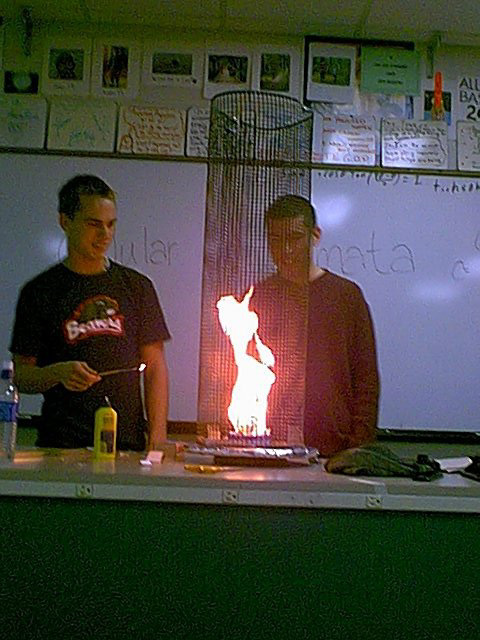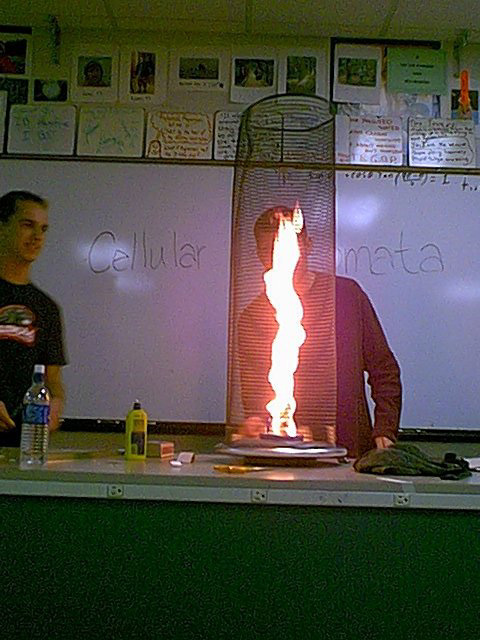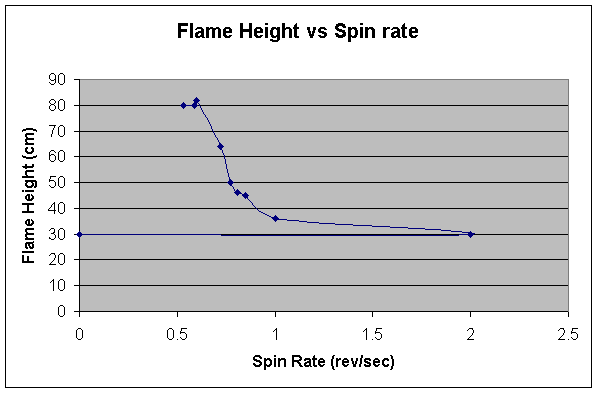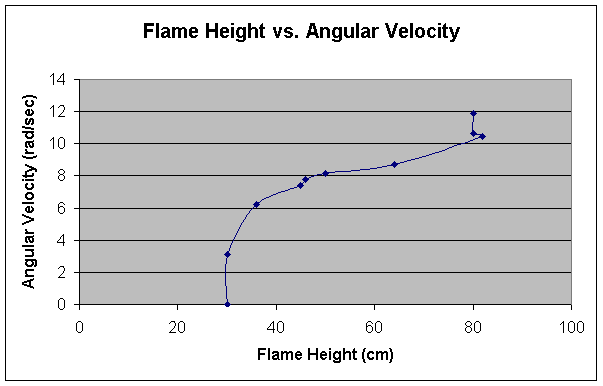
Flame Tornado Back to Physics!!!!!!!!!!!!!! website.......
A Physics Research Project by
Cooper Spear
Table of Contents
Background: We know that there are forces at work in a centrifuge. When an object is placed in a spinning centrifuge the centrifugal force will pull the object out, accelerating it outwards. This acceleration is known as centripetal acceleration. To find a centripetal acceleration you use the formula A = V^2 / R where V is the velocity and R is the radius of the object to the center of the centrifuge.
Convection is the process whereby heat is transferred by the mass movement of molecules from one place to another. (Physics Fifth Edition, Giancoli) When a molecules temperature is raised the heat transfer wants to go from a place of warmth to a place of relative coolness. This movement from hot to cold creates a current. This current has force in that where the molecule moves another one has to take its place. An example is when hot air raises cool air has to move to take its place. A gas is heated so it expands which decreases its density and becomes lighter than the air around it.
Bernoulliís theorem states that if velocity rises at a given elevation then, pressure must fall. This can be worked out in an equation: P / r + V^2 / 2 + gz = constant where P is pressure, r is fluid density, V is velocity, g is the acceleration of gravity (32 ft/s, 9.8 m/s), and z is the elevation.
Problem: Why does a flame grow taller when it is spun in a centrifuge?
Hypothesis: A flame will grow taller when it is spun in a centrifuge because the centrifugal "force" pulls air in and raises its velocity, which creates convection currents that pull the flame upward.

The centrifugal force pulls the air to the outside of the screen, which raises its velocity. The change in pressure pulls the heat of the flame upwards. We use a Lazy Susan and an electric motor to spin it at a constant velocity. A paper towel with some lighter acts as the flame fuel. A wire screen is used to give the air some containing body.
First we needed something to allow the flame to spin easily. I had a Lay-Z-Susan on my kitchen table and decided that that would do just perfect. After conferring with my mom about the use of the Lay-Z-Susan (from now on referred to as the spinner) we had to attach some barrier to stop any stray flames or oils from harming the spinner so we started with tin foil to cover it. That worked fine at low velocities. But we soon found out that at higher velocities the tin foil would stretch and allow the funnel to teeter and lose its balance. So using a lot of duct tape and a rounded piece of cardboard we had a sufficient cover for the spinner. On the first attempt at this project we used a tall plastic fence type thing as a funnel. After a few tests the exposure to the open flame made the funnel very flimsy and easier to fall. Another idea was needed. We needed something metal so it wouldnít melt and almost like a screen. So I went to The Home Depot and bought aluminum screening to replace screens on windows and doors. This didnít work. The screen was thinner than the plastic and actually easier to burn a hole through. Several attempts later we judged that the plastic worked better as it was sturdier and less likely to topple.

Now we needed a flame. Being a child pyro I new that I had lighter fluid and
add that to some simple paper towels and you have a flame ready to go. Like most
all first attempts this didnít work because we needed a consistent flame, one
that wouldnít go out as fast as the lighter fluid and paper towels. . We first
thought of tiki torches but couldnít find one at Fred Meyers so we settled for
the idea we were given of a Molotov Cocktail by Mr. Murray and just had to
figure out how to make one. Fred Meyers did have ultra pure lamp oil thought. We
got a bottle and filled it with the oil and stuffed a rag into it. This worked
for a steady flame. However, after testing it on the spinner we concluded that
flame would not rise no matter how fast we spun it. We tested out one more
Molotov Cocktail using a smaller bottle and a smaller section of rag sticking
out of the top, this failed again. So back to the original plan. We used the
lamp oil, though, instead of lighter fluid and along with a rag that worked
great for keeping a steady flame. The base we held it in was a cut in half pop
can. Using a lot of duct tape we fastened the can and the funnel to the spinner.
Using a meter stick with a match attached we were able to light the flame from
above.
In order figure out the angular velocity we attached a pen to the underside of
the spinner and along with a piece of tape on the ground we were able to time
how long it took to go around one revolution. We held a meter stick at ground
level and measured the flame height. To attain angular velocity we used a drill
to spin the spinner at a constant speed. We measured ten revolutions and
averaged the time for each height.


|
Time for one revolution. (seconds) |
Height of flame (cm) |
|
0 |
30 |
|
2 |
30 |
|
1 |
36 |
|
.85 |
45 |
|
.81 |
46 |
|
.77 |
50 |
|
.72 |
64 |
|
.6 |
82 |
|
.59 |
80 |
|
.53 |
80 |
After ten tests we came up with the following data.
To figure out the velocity we used the formula w = 2p /t. Where w is angular velocity and t is time in seconds. With this added to the table we have this.

|
Time for one revolution. (seconds) |
Height of flame (cm) |
Angular Velocity (rad/sec) |
|
0 |
30 |
0 |
|
2 |
30 |
3.14 |
|
1 |
36 |
6.22 |
|
.85 |
45 |
7.39 |
|
.81 |
46 |
7.76 |
|
.77 |
50 |
8.16 |
|
.72 |
64 |
8.73 |
|
.6 |
82 |
10.48 |
|
.59 |
80 |
10.65 |
|
.53 |
80 |
11.86 |
On a graph this looks like this-
Obviously from the graph we found that the rate of spin, or the velocity, determines the flame height. Also according to the graph the flame height will top off at a certain height, in our case at about 10.5 radians a second. We tried different variations on the working setup including smaller and bigger funnels not only height wise but also diameter wise. We found that a wide diameter funnel worked the best and also that the funnel height didnít seem to have an effect except to say that with no funnel at all the flame will not rise. Also the different flames didnít seem to work. The Molotov Cocktails didnít work because the flame burnt from the bottom and the sides and not the top due to this problem the flame couldnít transform into a tornado.
Encyclopedia of Science and Technology, McGraw-Hill, 2002
Physics Fifth Edition, Douglas C. Giancoli, USA, 1998
http://chemmovies.unl.edu/chemistry/beckerdemos/BD009.html-this site is basically an overview of the experiment. It outlines our experiment very well.
http://www.efluids.com/-this site can give you an overview of fluid dynamics. Fluid dynamics has to do with fire.
http://www.learnz.org.nz/2k/tongariro/t_convection.htm-this site was used to research convection currents.
http://www.thinkquest.org-this is a search engine type site that was helpful in finding the physics of our experiment.
http://www.physics.com-all about physics. Same as above.